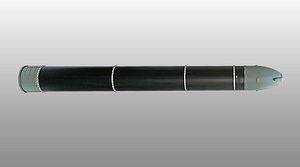Russia’s deadliest new nuclear weapon currently under development, the new super-heavy thermonuclear-armed intercontinental ballistic missile (ICBM) RS-28 Sarmat may be in trouble, the Russian Nuclear Forces Project (RNFP) reports.
One sign: repeated delays in the missile’s first ejection test, which tests the mechanism of a missile leaving its launch container, according to a January 19 blog post on the RNFP website.“The first sign was the delay with be first ejection tests–they were moved from 2015 to the end of 2016 and now to 2017 (for all we know, this may be the end of 2017). The delay was sort of explained by a problem with the test silo, but that explanation never sounded very convincing,” the article notes.
Another sign is Russian Defense Minister Sergey Shoygu’s is apparent dissatisfaction with the Sarmat program’s progress: “He promised that the ministry of defense will demand weekly reports on the progress with development of ‘prospective strategic missile systems’ that are built at Krasmash [a Russian defense contractor building nuclear weapons for the Russian Strategic Missile Force]. The idea, he said, is to check that the project meets the milestones that were set at the end of 2016, when these milestones were adjusted.”
The website notes that all of this merely provides circumstantial evidence and it is nearly impossible to assess the actual progress of the Sarmat program. However, it is important to understand that Sarmat is Russia’s top ICBM development program and the missile is slated to become the mainstay of the Strategic Missile Force’s silo-based ICBM force.
A delay could have major implications for the Russian military’s overall modernization efforts.
The missile is expected to enter service by 2020, replacing replacing Soviet era RS-36M ICBMs. As I noted elsewhere, Moscow intends to retire all Soviet-era ICBMs and replace them with new weapon systems by 2022. Should the Sarmat program be delayed, this deadline will inevitably have to be pushed back.
So far, we know of one single test of the new weapon system. In August 2016, the Sarmat’s first stage engine, named PDU-99, was tested. Analysts believe that the engine is a modified version of the RD-274 liquid rocket engine used on the RS-36M ICBMs. However, it is unclear whether the test was successful or not.
In May 2016, the head of the Russian Strategic Missile Forces was optimistic about the Sarmat’s progress and highlighted its potential in an interview with Russian state media. “The development of the Sarmat silo-based missile system with a heavy missile is nearing completion,” Colonel-General Sergei Karakayev, said (See: “Russia Developing New Nuclear Missiles Capable of Penetrating US Defenses”). “The performance of the stationary grouping of the heavy ICBM (of the Voyevoda or Sarmat class) will four times surpass that of the stationary grouping of the light-class ICBM (Topol-M, Yars) by all the RVSN [Strategic Missile Forces] grouping tactical effectiveness parameters,” he added.
In was only in October 2016, that the Makeyev Rocket Design Bureau posted a declassified picture of the prospective new missile on its website. The Sarmat can reportedly carry ten heavy or 15 (some sources say 16) lighter warheads. The new ICBM can allegedly also be fitted with a new hypersonic glide vehicle (HGV), the YU-71, currently in development under the secret Project 4202. The YU-71 is a warhead purportedly capable of penetrating any Western missile defense system.
































